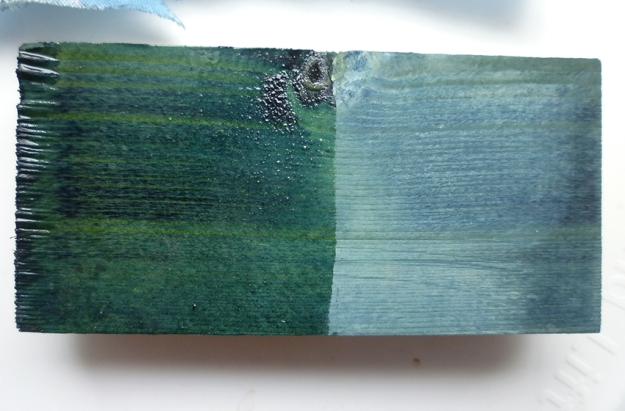So what am I doing with the vats? At this point I’m primarily interested in seeing how easy they are to assemble and run, and what the pH is, information that will help me to choose vat methods for dyeing projects in the future. Mostly I will be dyeing wool for spinning and spun yarn for weaving, but it’s a shame not to investigate other possibilities.
Fabric is an obvious choice; it would be impossible to dye garment lengths in my relatively small jars, but I can play with techniques I haven’t used before, such as shibori. Well, used seriously. Like anyone growing up in the 1960s and 70s I did my fair share of mad tie-dyeing, but there are many other, more disciplined techniques. I have a thing about grids, regular patterning, so itajime (shibori patterning created by pressure) with squares of wood caught my eye. Two 1.5″ squares of board, some string and a strip of silk were easy to assemble… on reflection, for my first attempt, I should have tried larger squares and cotton, because ironing the slippery silk into the necessary neat square packet was exceedingly difficult. Tightly tied between the squares, the folded silk was thoroughly soaked in tap water with a drop of detergent as wetting agent before spending about 10 minutes in the fructose vat, reheated to 50°C and revived with 5g indigo, 10g, calcium hydroxide and 15g fructose.
Opening it was my reward for doing the ironing; an hour later and a rinse in vinegar later, I had this:
Lots of room for improvement, but proof of principle nonetheless!
Note the rather pretty patterns on the wood squares. Indigo will dye anything that has roughness to trap the particles. Tokushima Prefecture in Japan is trying to find new products for its traditional indigo vats, including wood for speaker cabinets and mug mats as well as fabulous flooring. I moved the fructose vat into a jar in the greenhouse after dyeing the silk in it last weekend; although it was not heated, I noticed there was a thin flor on the surface, so I dropped a scrap of wood into it for a day, removed it for a couple of hours to dry, then put it back for another day.
Fresh from the vat it was a beautiful green blue. Note that the dense wood associated with the knot has absorbed less of the indigo.
Almost dry and it’s definitely blue.
Three days later, fully dry, I’ve given half of it a single coat of yacht varnish, the only glossy thing I have to hand. Sadly it’s slightly yellowing, whereas I think those floors are protected by a thick layer of perfectly clear polyurethane.
But still, pretty. Worth a few more coats, I think.






Delightful reading. Thank you very much.
I suppose indigo is discovered accidentally. But do fresh leaves suggest themselves as a source of blue dyes through rubbing or damage?
LikeLike
When they contain indigo (see my other reply to you) japanese indigo leaves do turn blue when bruised. Dead, dried leaves also have a blue tinge. But woad doesn’t bruise blue. Different plants may contain different indigo precursors, and those in woad don’t react in the same way as those in Japanese indigo. I’d love to know how other plants containing indigo behave, but I can’t grow tropicals here. I’d also like to know how the standard process of fermenting plant material that contains indigo developed.
LikeLike
Thank you very very much for your prompt reply. It is really helpful.
I shall write an article on my column in a local Chinese newspaper this Sunday and include your comments and the newspaper may use your stained wood photos. Should we acknowledge you and the photos to Sarahw?
I can email to your my previous articles on indigo.
Thank you again.
LikeLike
Or you can find me on Facebook and the images of the articles
LikeLike
What fructose brand do you use? I bought mine online and it is a dud- probably corn fructose!
And before I buy from one of the studios like Dharma or Maiwa, I’d like to know the brand not get a container with no information!
LikeLike
Hi Karthika
Technically fructose is nothing more than a specific type of sugar. The source of the fructose shouldn’t matter; just make sure you buy the pure powdered fructose, not a syrup. If in doubt I’d buy from Maiwa, but I bought mine from Amazon.ca (https://www.amazon.ca/Now-Food-FRUCTOSE-3-LB/dp/B001F8ROTG/ref=sr_1_1?crid=UG8HAIKIIW2R&dchild=1&keywords=fructose+powder&qid=1605462122&sprefix=Fructose%2Caps%2C215&sr=8-1).
LikeLike